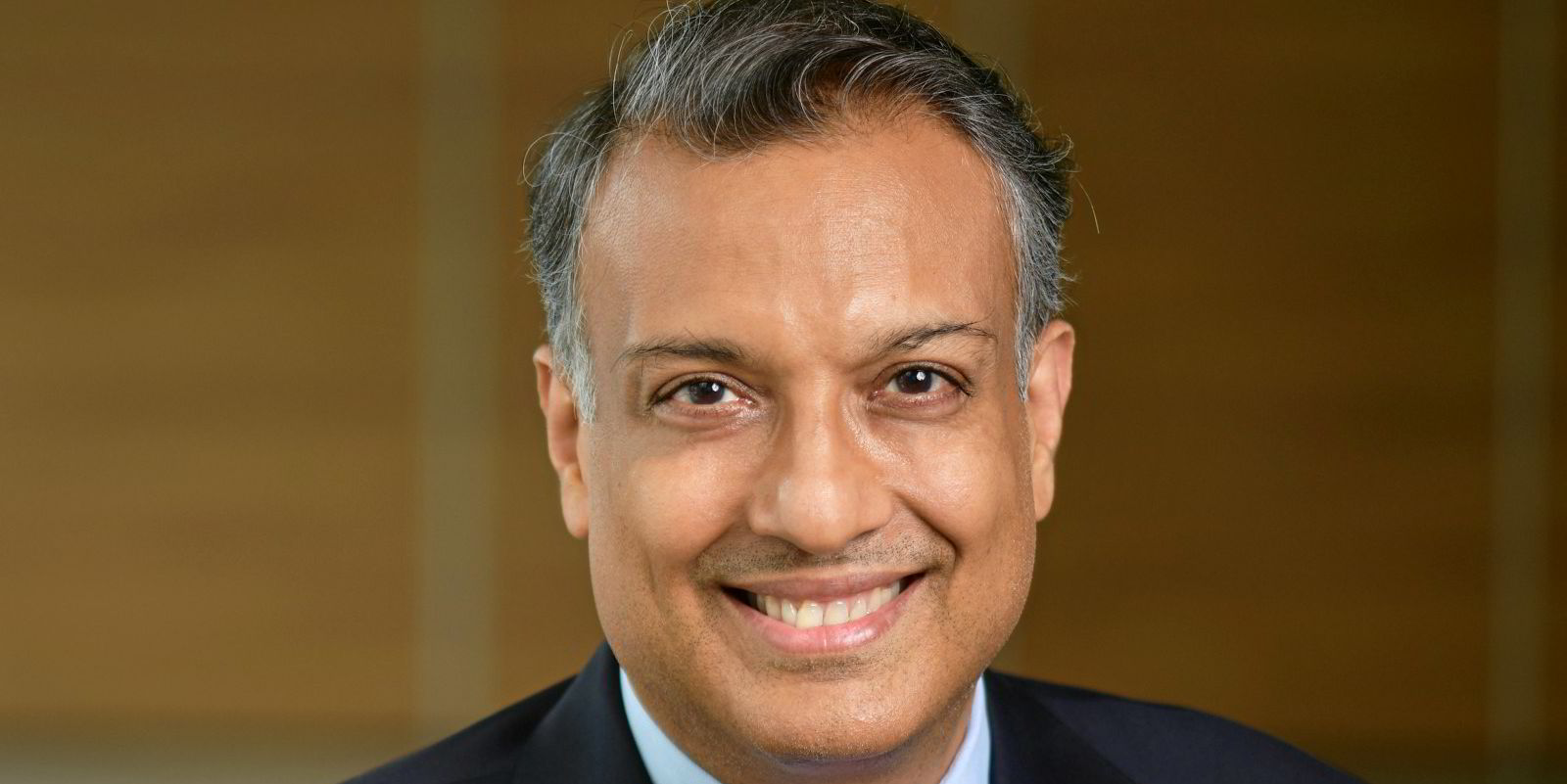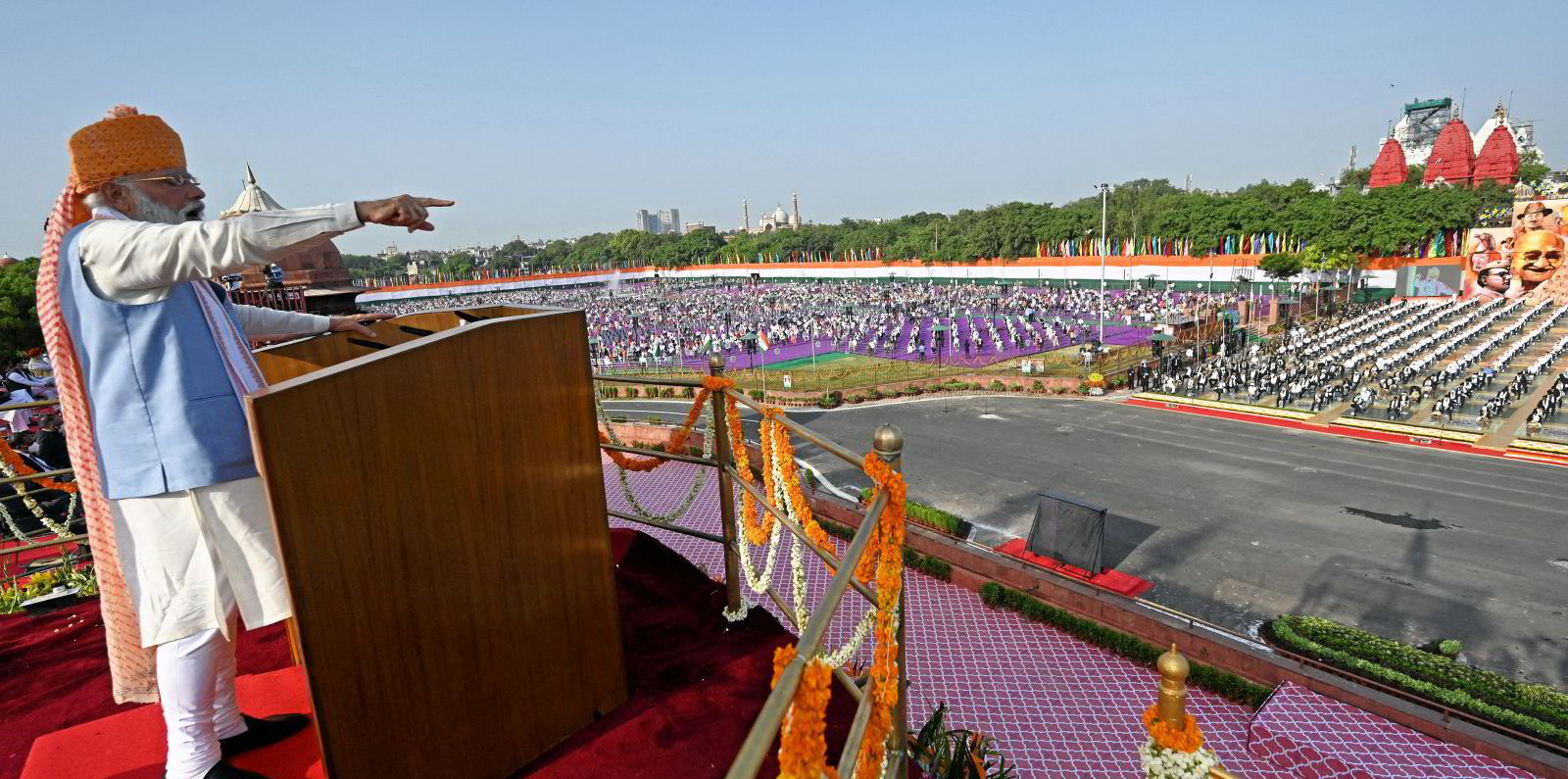PAKISTAN
WHEN THE STUDENTS MARCH
Xari JalilPublished December 5, 2021

A sea of red flags can be seen at the Students’ Solidarity March in Lahore | M Arif/White Star
Students in 11 cities took to the streets during last week’s Students’ Solidarity March. After months of planning and organising, they were finally able to come together and voice their concerns. The fiery students have shouted these slogans before. But is anyone listening?
Asea of red flows along Lahore’s Mall Road. Red flags bob along with the marchers who have adorned themselves in red hats, shirts or coats. They stand out beautifully against the smog-ridden grey of the city’s overcast horizon, as if signifying their tumultuous anger against the bleak backdrop of the country’s situation.
One of the marchers is holding a placard. He stops on the side and grins for a photograph.
“Bhagat ki raah humari hai, Jang humari jaari hai [Bhagat’s path is ours, Our struggle continues],” his yellow placard says, remembering the revolutionary Bhagat Singh.
The students are rallying for the restoration of student unions this year, as they did last year. But they have other demands too.
“Free Ali Wazir,” some placards read. (The incarcerated MNA and Pashtun Tahaffuz Movement leader was granted bail in at least one case days after the march).
“Sohail Baloch aur Faseeh Baloch ko baazyaab karo [Recover Sohail Baloch and Faseeh Baloch],” other placards read, referring to the two Baloch Students Organisation (BSO) activists who were abducted a few weeks ago and are still missing. Despite promises by the government, they have not yet returned home. As a result, educational activities at Balochistan University have been suspended, yet again.
The students who have come out for the Students’ Solidarity March are angry and full of verve. They are ready to take on the world today, chanting slogans for their freedom and rights. This is their day and they won’t be pushed around by anybody.
The road to this day has been long and their frustrations have been mounting.
***
In August 2021 a study circle was disrupted at Punjab University (PU), a hub of student politics. The Taliban had recently taken over Afghanistan and the Progressive Students’ Collective (PSC), an offshoot of the Haqooq-i-Khalq Movement (HKM), had decided to hold a discussion on issues of human rights violations there.
But the Islami Jamiat-i-Talaba, a student group of the Jamaat-i-Islami, apparently did not like the idea, and a clash broke out. Rae Ali Aftab, the general secretary of the PSC was beaten up badly. He claims he was being dogged by the Jamiat ever since they learnt of the study circle.
Later, PSC members claimed that the Jamiat attacked them, but the religio-political party denied PSC’s version of events.
“The discussion was about the Taliban takeover of Kabul, and the Jamiat has been trying to force us to stop,” Aftab says, looking back at the incident. The clash apparently intensified because the PSC students stood their ground. Aftab claims that he and his friends were charged with sticks and he was left with several bruises all over his body.
A few days after the clash, members of the Pashtun Education Development Movement (PEDM) and PSC held a rally outside the Punjab Assembly. They alleged that the university management took no action against the students who had disrupted the study circle and physically intimidated student activists.
Tensions have been rising on campuses, with some students claiming they have been ‘picked up’ and intimidation tactics have been used against them to keep them from protesting and taking part in student politics.
The last few years have not been kind to students. From the passing of the controversial Single National Curriculum to the abductions of students, and from fee hikes to examination problems, students have been growing more and more restless.
In March 2021, students belonging to the former Federally Administered Tribal Areas (Fata) region, who were studying at the Islamia University Bahawalpur, staged a sit-in outside the Punjab Governor House for around a week, demanding restoration of students’ scholarships and quotas. After military operations in the region destroyed the education infrastructure there, the Punjab government under Chief Minister Shahbaz Sharif had promised reserved seats with quotas and scholarships for students from ex-Fata in all the public sector universities of Punjab. And while the Pakistan Tehreek-i-Insaf (PTI) promised to double these seats before they took office, when they came into power, the seats were cancelled altogether, because of “austerity measures”. The matter remains unresolved.
The above are just two incidents from this year alone. The last few years have not been kind to students. From the passing of the controversial Single National Curriculum to the abductions of students, and from fee hikes to examination problems, students have been growing more and more restless. Yet, the students say, the government’s response has been that of indifference.
On top of everything, religio-political groups on campuses have been getting more active and are showing more and more radical traits.
Now, after three previous marches, this year too, droves of students took to the streets to make their demands known. Getting them out on the streets was no easy task. It has taken dedicated work and organising on the ground.
MOBILISATION

Women wearing masks chant slogans at the march | M Arif/White Star
After this year’s march, held on November 26, many members of the PSC — the most prominent group in attendance and the organisers of the march — considered it a huge success. In Lahore, hundreds of young people, supported by civil society, lawyers and human rights activists, had rallied together to Charing Cross (Punjab Assembly).
“We have just recently inducted new members — around 700 of them — and from this one can just see the scale of the march,” says Muhammad Zubair Siddique, an activist and student at the National University of Modern Languages in Lahore. “We marched in 11 cities, including Islamabad, Karachi, Lahore, Peshawar, D.I. Khan and Multan,” he proudly shares.
Dr Alia Haider, a prominent member of PSC’s mother party, the Huqooq-e-Khalq Movement (HKM), and a doctor who does volunteer work, says that students conduct study circles all year but, a couple of months before the march, their frequency increased to two to three study circles in a week. “Students from PU went to different institutions to talk to students,” Dr Haider says.
She says that students from HKM also went to working class areas to mobilise students. “Our motto is ‘Aurat, mazdoor, talaba, kisaan [women, labourers, students, farmers],’” she tells Eos. HKM has had drives and campaigns in areas such as Chungi Amar Sadhu and engaged families of factory workers there. “There are [only a few organisations] who talk about the issues faced by students or working class individuals,” Dr Haider says.
The connections these activists make are not just for the march. “They are there with us all year round,” she says.
This year’s march was the fourth Students’ Solidarity March. The first one was in 2018. The second took place in 2019, and was the biggest march so far, with students taking to the streets in 50 cities. The 2020 march was smaller, partly because of the Covid-19 threat, but still managed to cause a stir when activist Ammar Ali Jan and some others were almost arrested by the police for supposedly being a “potential danger to public peace, [and the] law and order situation.”
But even after three years, organising the march continues to be an uphill task every year. This year was no different. In fact, some students say there were added challenges in the lead-up to the march, which resulted in a comparatively lower number of students marching.
THE CHALLENGES OF COMING TOGETHER

PU students hold a study circle
Even as the Covid threat seemed relatively smaller this year, some felt the organisers were still unable to bring back the kind of numbers they had seen before. Aiman* a student who marched back in 2019 and was back this year too, felt disappointed this year.
“In the 2019 march there were many more students, actual students, who came,” she says. “This time, there were very few genuine students. Most of the people were those who are [no longer at] educational institutions, so these issues are not really their issues.”
As the march drew closer, Aiman could already see the organisers getting complacent, she says, adding that the organisers are divided into different groups, and it is difficult to bring them all together under one umbrella.
While not everyone agrees with Aiman’s assessment, they acknowledge that organising a march of this magnitude is challenging.
Salman Sikandar, another student activist, says that the biggest challenge during mobilisation was having a presence on social media — an area student activists have excelled at in the past. But while they may have lagged behind on that front this year, they were much more active on the ground, Sikandar says.
“We went inside metro buses and told students about the march,” he says. “We saw [students] sitting around in market places such as Anarkali, at Wahdat Road, at cafes inside Barkat market and even inside hostels, and then we went to talk to them,” he says, adding that this is why there were over a thousand students at the march in Lahore, by his estimation.
Sikandar says that, in the pre-Covid march in 2019, the gathering wasn’t completely organic. There was hype on social media, with content going viral and even trolls unintentionally helping spread the message. Then there was the novelty value. The media was more interested and calling the student activists. All this helped them get bigger numbers at the march.
Mahnoor believes that students must be decision-makers about their own issues. She proposes electing student representatives for the harassment committees. She also questions why the policy states that there should be at least one female on the committee. “Why one?” she asks.
Besides, when the students marched in 2019, Sikandar points out, there was a historic student protest happening in India as well. “We stood up in solidarity for them, and they for us. This was a huge reason.”
But while the media and the social media ‘trolls’ may have moved on, the students have continued the work on the ground. Sikandar says that this year too, students from the Pukhtoon Students Federation, the Peoples Students Federation, the Revolutionary Students’ Front, and the Jammu and Kashmir National Front, all took part in the march.
But having said all that, Sikandar does allude to disagreements within the organisers. “Sadly the left wing tendencies are that they do not support each other,” the student says. “We received a video of [former Prime Minister] Shahid Khaqan Abbasi, saying that he supported the march, but our own people kept condemning it.”
Sikandar also says that one criticism they hear is that the march is dominated by Punjab, especially Lahore. This isn’t necessarily untrue, he acknowledges, and he would completely understand if the criticism were coming from Baloch students. “But if I hear someone in Islamabad saying this, it is a bit much,” he says.
These disagreements are a part of student politics. And while the marchers may not see eye to eye on all matters, they were clear on why they were marching.
STUDENT UNIONS

A student activist spreads the word about the march at a cafe
If these students remember one thing about former Prime Minister Yousuf Raza Gilani’s rule, it is that, in 2008, he stood up in the National Assembly and promised to reinstate student unions. But Gilani did not stay in power for long, having been slapped with corruption charges. All the other successive governments also promised to restore the unions. But, to this day, nothing has happened.
Banned back in the 1980s under Gen Ziaul Haq, student unions have remained defunct. In the meantime, wings of national political parties made their way into educational institutions, especially public colleges and universities, changing the concept of student politics into a ‘militant’ manifestation of these mainstream political parties. Violence on campus increased drastically as a result.
“The violence increased after the 1984 ban,” says Qaiser Javed, the President of the PSC. “Yes, there was violence, but why was there a blanket ban on unions? There is violence during the elections too, but no one says they should be banned.”
Javed says that the governments are actually scared of a new leadership emerging, that may be better than their politicians. He believes that they are scared of the power that students wield. “But unions are the need of the day,” he says, repeating a sentiment that was widely held at the march. “When the PML-N [Pakistan Muslim League-Nawaz] came to power they did not restore the unions. Neither did the PPP [Pakistan Peoples Party] and nor did PTI.
“Imran Khan paints an image that he is all about human development and not infrastructure,” Javed says. Still in 2019, a 45 percent cut was imposed on the higher education budget and universities were told to generate their own budgets. “In the beginning we had hoped that something new would come out of the current government’s rule, but there is absolutely nothing that we, as the youth, can benefit from,” he adds.
“They were scared about the 1968 movement, when students made Ayub step down,” says Javed. “Then in 1988, Benazir Bhutto restored [student unions], but only for a short while. Now universities take an affidavit at admission that you will not take part in political activity. But even if you sit on campus it’s political. There is nothing that is apolitical. And our constitution allows us basic rights, such as freedom of assembly, or speech and expression.”
Javed says that after the Tehreek-i-Labbaik Pakistan (TLP) ‘fiasco’, the government has no business telling students not to demand their rights.
Minister for Human Rights Shireen Mazari herself tweeted in support of the student march. She said that being someone who has taught for over 16 years, she has always supported student unions and maintained that the onus is on university authorities to ensure that the unions function according to the rules that have been laid out.
But students who feel like their demands fall on deaf ears are not convinced by the tweets. “If she supports us so much, then why are we being treated like this by the government?” asks a student, referring to what they see as indifference from the government on students’ issues.
OTHER DEMANDS

A volunteer hands out flyers to students
Another major demand besides the restoration of student unions, is that the Higher Education Council’s (HEC) law on forming harassment committees must be implemented more strictly and female students must be represented on the committees. The activists also asked that hostel students be supported with medical expenses, as the country continues battling Covid-19 and dengue. They also demanded that students be given concessions on transportation, which seems to be getting more expensive every day.
Finally, the students demanded that campuses in Sindh and Balochistan should be demilitarised. And abducted students must be released at once.
The students have marched with these demands earlier as well, but with little success.
“The government is not taking any of our demands and complaints seriously,” says student activist Siddique, lamenting the fact that the education budget is very limited.
“The government is not really interested in improving the education sector,” he says. Siddique points out that the fee hikes continue. And claims that even the limited seats given on the basis of provinces are given out because of nepotism, instead of merit.
He also believes that there is little interest in creating safer campuses where women would not get harassed. The harassers, especially if they are members of the faculty, appear to have impunity and no action is taken against them, he says.
HARASSMENT ON CAMPUS

A student activist speaks to other students in the lead-up to the march
Bushra Mahnoor, who is part of the Feminist Collective, has been fighting for the implementation of the 2018 HEC policy on forming anti-harassment committees at universities.
The issue has continued to persist and even some of the country’s biggest universities have had cases that became national talking points because of their mishandling.
Mahnoor points out that while the policy says that all educational institutions must make these committees, it does not highlight what the consequences would be for not following through.
“Unfortunately, the inquiry committee also has no representation of students,” she says, adding that if there were student representation, maybe the issues would be tackled better. “Teachers also don’t want to get involved, especially if a complaint against a colleague has come,” she points out.
Mahnoor believes that students must be decision-makers about their own issues. She proposes electing student representatives for the harassment committees. She also questions why the policy states that there should be at least one female on the committee. “Why one?” she asks. “It’s 2021, for God’s sake.”
Information regarding who should be called or contacted to report harassment should be very clearly communicated to everyone on campus, the students say. While some universities have taken the initiative to do this, most have lagged behind. Fatima* faced the consequences of this first hand.
When a boy passed sexual comments about Fatima, she did not know where to go and who to contact. She went to a senior of hers and showed her a video of how lewd the boy had been with her. This would happen in front of everyone and even the guard turned a blind eye to the harassment and ‘catcalling’, enabling the boy’s behaviour.
“I had no idea who to turn to,” she says. When she finally did and made a complaint, it bore no results and the boy was let off scot-free.
Dr Alia Haider says that the harassment issue is one big reason why parents do not send their girls to study. She refers to the case of Nimrita Amarta Maher Chandani, where it was found that the young woman had been sexually assaulted before she was murdered in her hostel in Larkana.
“There are many girls who don’t bother complaining or, even if they do, they are not heard,” Dr Haider says.
Mahnoor says that women are kept so apolitical by their families that, when they are approached to join in for a cause, they are hesitant. They are scared the college administration will throw them out. It could happen too, the way things are going, she says.
THE WAY FORWARD
Farooq Tariq, a senior labour leader says that campuses are reflections of society. They are not isolated bubbles. If it’s happening on campus, it’s happening outside in society too.
“The government is scared of students being allied,” he says. “They think that they can control the institutions better instead of organised students.” Tariq points out that if students are allowed to unionise, then demands will come forward. A strong believer in the power of the students, he says that those in power will have to make a budget, arrange better transport and give concessions. “And they don’t want this,” he tells Eos.
When Tariq was elected a president in PU, he remembers how powerful and important he felt. “We used to have a vibrant and intellectual atmosphere, with politics, discussions, programmes and critical thinking,” he says. “We had decision-making power. Today it’s all about anti-intellectualism.”
In order to make a change, we have to have a nationwide movement which can help with the revamping of the system, Tariq says. “Because, simply put, today students have had enough.”
The Students’ Solidarity March may be a start of such a movement. These politically-charged young men and women are only getting started.
*Name has been changed to protect identity
The writer is a journalist who reports on various issues from human rights to society and art. She tweets @xarijalil
Published in Dawn, EOS, December 5th, 2021









 Comparisons between highly vaccinated nations and those at the bottom, most of which are in Africa. — From: Our World in Data.
Comparisons between highly vaccinated nations and those at the bottom, most of which are in Africa. — From: Our World in Data.

















